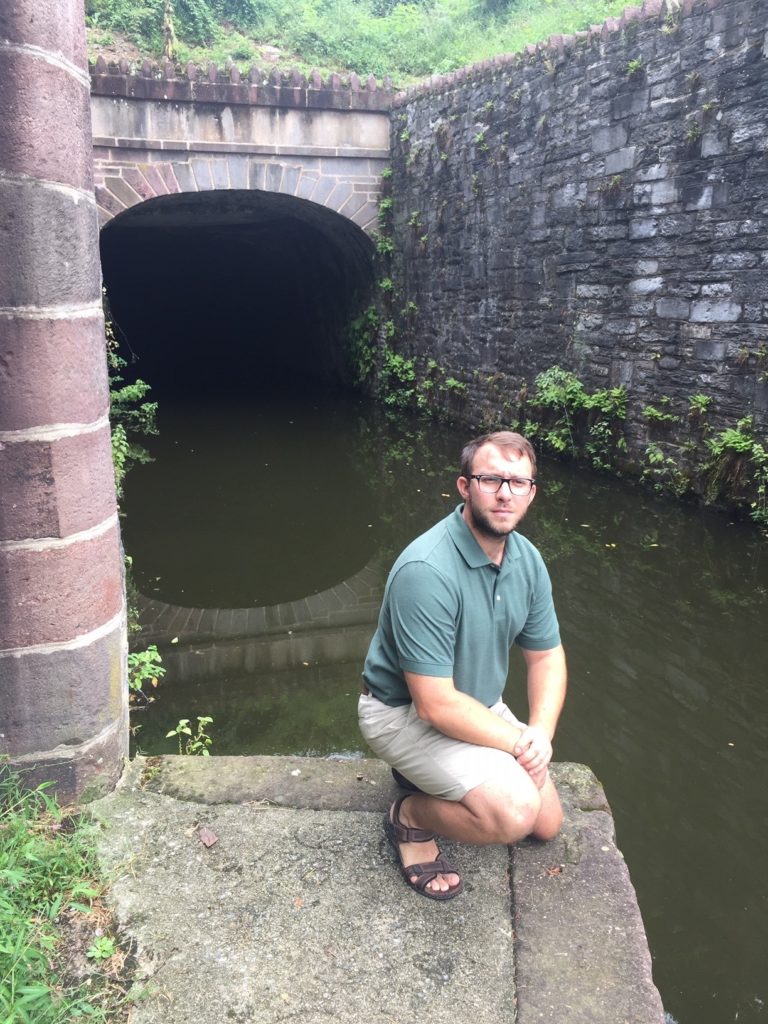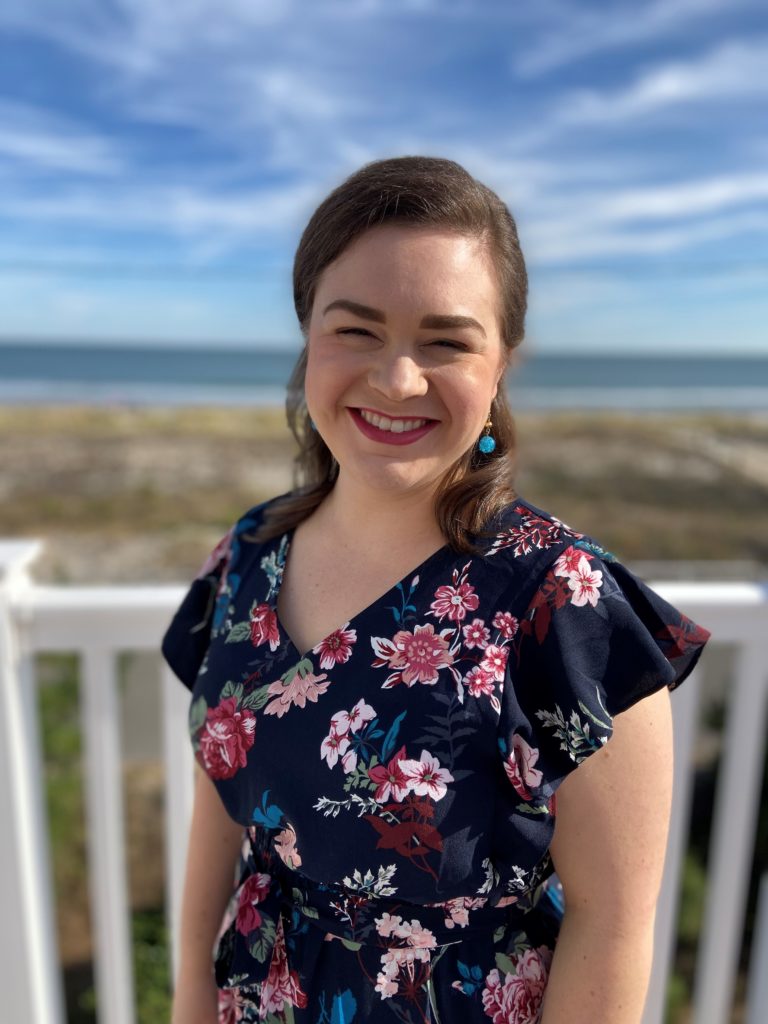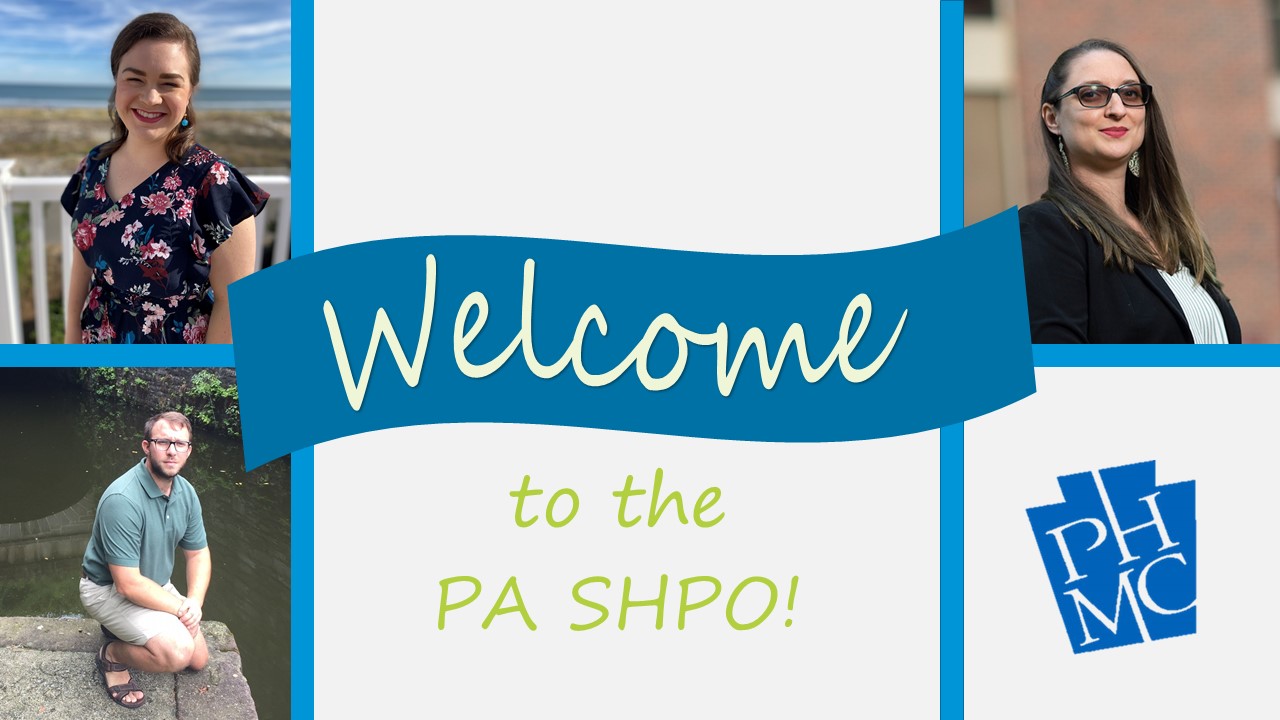Since the last time I officially welcomed our new SHPO staffers, three new colleagues have joined our team. We are very excited to have Megan McNish and Frank Grumbine as the new Eastern and Central Region Community Preservation Coordinators and Alli Davis as the new Historical Marker Program Coordinator. I’m also happy to announce Casey Hanson’s promotion!
Tell us a bit about yourself and what you do at the PA SHPO.
Alli: I was born and raised in rural Montgomery County, but most of my family is from the Norristown area. For college, I decided to go “far away” and went to Lycoming College in Williamsport, where I studied Near Eastern Archaeology. Since then I’ve realized just how “far away” I could go and lived in New York City, Israel, and Oakland, CA before making my way back home to Philadelphia to study Historic Preservation at the University of Pennsylvania’s master’s program.
As the Historical Marker Coordinator, I have the very fun job of learning about Pennsylvania’s extremely diverse history. Currently, I’m in the middle of reviewing nominations for new Historical Markers and finalizing the markers and dedications for the past year’s approved nominations. I also work with our maintenance contractor to spruce up faded and damaged markers. You can reach me at allidavis@pa.gov.

Frank: Born and raised in Central PA and current native of northern York County. I’m a graduate of Shippensburg University where I studied history and anthropology. I’m an avid naturalist and explorer and am an advocate for the conservation and preservation of natural and cultural resources. I consider myself an environmental historian and am endlessly curious about the world around us and the interplay of the human experience and the environment. I’m an amateur mycologist and spend my time hiking in state parks and forests and enjoy experiencing new places.
As the Central PA Community Preservation Coordinator, I collaborate with communities to preserve and protect cultural resources through identification, education, and planning. I use my experience in historic preservation construction, planning, and conservation to help communities leverage state programs to protect unique resources to build strong, vibrant, and inclusive communities. Additionally, I try to make sure that preservation is considered at the local level when decisions are being made. You can reach me at fgrumbine@pa.gov.

Megan: I was born and raised in Rutherford, New Jersey and am an alumna of Gettysburg College, where I majored in history with minors in Civil War Era studies and public history. Following my undergraduate studies, I attended West Virginia University and obtained a master’s degree in public history.
I am the PA SHPO’s Eastern Region Community Preservation Coordinator. In this role, I assist Certified Local Governments, municipalities, and community partners with preservation regulations, challenges, and technical assistance. Prior to joining the SHPO, I was a preservation planner for the City of Columbia, South Carolina and worked seasonally for the National Park Service as a park guide. You can reach me at mmcnish@pa.gov.

What have you found to be the most exciting/rewarding part of the job so far? Most unexpected or challenging?
Alli: I love sharing people’s passions for their history. There is so much unique, unusual, and important history of our Commonwealth and I feel very special to participate in celebrating that.
Frank: I have found the most rewarding part of my position is helping people connect with their past and sense of belonging while collaborating with others to promote positive and impactful change. The most challenging part of my position is being able provide the best possible assistance to all who need it throughout my 28 county region.
Megan: I love that each day brings something new—a new challenge, the chance to meet and work with Pennsylvanians who are passionate about their state’s history, and opportunities to learn something new. I’m excited to continue to travel in the Eastern Region and get to know the communities here on a personal basis.
As a child, what did you want to be when you grew up?
Alli: At first, a veterinarian, but then an archaeologist!
Frank: Being a kid in the 90’s, I was obsessed with the film ‘Jurassic Park’ and immediately wanted to be a paleontologist. I became fascinated with the past, particularly natural history, and wanted to learn everything I could about animals, biology, ecology, and history. This eventually evolved into my interests of anthropology, material culture, and history.
Megan: Growing up I wanted to be costumed interpreter at Colonial Williamsburg.
As an adult, what made you choose this as your career path?
Alli: So much of people’s identities come from their shared histories. There is so much to learn and understand about different cultures and beliefs, even within our own communities. I take a lot of joy participating in helping communities preserve and tell their histories.
Frank: As a young adult I experienced firsthand the rapid change and development that continues to destroy historic farms, unique landscapes, and sensitive habitats. With a background in trades, particularly working on and around historic buildings and materials, I felt hopeless that this rapid change was inevitable. I was unsure how my love for history and the environment could be blended into a career path to help drive positive outcomes until I realized that historic preservation is a perfect match for me to help these communities.
Megan: In some ways, I stumbled on preservation as a career path after taking a couple classes in grad school. I’ve ultimately stayed in preservation because I’ve seen firsthand the positive impact that preservation can have a community. Whether through rehabilitation or adaptive reuse, preservation of individual structures or districts helps communities retain a sense of place while also reinvigorating formerly underutilized spaces. To see that transformation, and be even a small part of it, is incredibly rewarding.
If historic preservation were a song, which one would it be?
Alli: I would say Whitney Houston’s “Greatest Love of All.” Her lyrics are about finding pride within yourself and teaching the next generation. In the same way, Historic Preservation is about having pride in your history and sharing it for future generations. “I believe the children are our future / Teach them well and let them lead the way / Show them all the beauty they possess inside / Give them a sense of pride to make it easier / Let the children’s laughter remind us how we used to be”.
Frank: Big Yellow Taxi by Joni Mitchell sums up many of the reasons why historic preservation and environmental conservation are important.
Megan: I would say Old Time Rock & Roll by Bob Seger and the Silver Bullet Band—there are so many sentiments in that song that apply to preservation. ‘I’ll sit and listen to ‘em by myself’—sometimes all it takes is one person to believe in the importance and value of a building to turn things around or ‘Today’s music ain’t got the same soul’—many modern buildings lack the attention to detail and craftmanship that often makes historic buildings special.
What is the number one thing you would like people to know about historic preservation?
Alli: Historic preservation is about YOU and your community preserving your identities and histories and continuing them through the next generation. Historic preservation isn’t about keeping something stagnant and perfect, either. Humans grow, evolve, adapt, and make lasting impressions on our environment and each other. Historic preservation tells the story of how we change throughout time.
Frank: Historic preservation is not just saving old buildings. It is helping to identify and protect unique cultural assets that define who we are and how we engage with our past including landscapes, archaeological sites, and viewsheds. Historic preservation helps to revitalize communities by fostering economic growth through adaptive reuse, experience economies, and heritage tourism. Furthermore, it helps us to learn from our mistakes of the past by identifying and preserving tangible reminders of these narratives.
Megan: Historic preservation is a great tool that can assist communities in accomplishing a variety of goals! While preservation for historic, architectural, or cultural significance is the driving force behind a lot of preservation efforts, stakeholders may come to the table for a variety of other reasons. Whether its economic development, community planning, revitalization, or sustainability, these stakeholders, who may not call themselves preservationists, are just as important and their reasons for supporting preservation are just as valid. Preservation can be one of many tools used to further these goals.
New Archaeology Supervisor, too!
I am also excited to announce that Casey Hanson, who has been with us for a few years as an archaeology reviewer in the Environmental Review division, has been promoted to the newly-created position of Archaeology Supervisor. You may remember when we officially welcomed him in this post last year.

I asked Casey what is on his to-do list as the new supervisor. He hopes to grow the Archaeology Section [in the Environmental Review division] and expand what they do beyond Environmental Review through working more collaboratively with PA SHPO’s P.A.S.S. coordinator, the State Museum, partner agencies, and the public.
Thank you… and Welcome!
A hearty thank you to Megan, Frank, Alli, and Casey for being good sports and answering my questions.
Now, I will leave our readers with the same question I asked my new colleagues: If historic preservation were a song, which one would it be?
Comment Policy
PHMC welcomes and encourages topic-related comments on this blog. PHMC reserves the right to remove comments that in PHMC’s discretion do not follow participation guidelines.
Commenters and Comments shall be related to the blog post topic and respectful of others who use this site.
Commenters and Comments shall not: use language that is offensive, inflammatory or provocative (this includes, but is not limited to, using profanity, obscene, or vulgar comments); disparage other commenters or people; condone illegal activity; identify the location of known or suspected archeological sites; post personal information in comments such as addresses, phone numbers, e-mail addresses or other contact details, which may relate to you or other individuals; impersonate or falsely claim to represent a person or an organization; make any commercial endorsement or promotion of any product, service or publication.
If you would like to comment on other topics not related to this blog post but related to PHMC, please fill out the PHMC Contact Us Form.

Congratulations to the newcomers and the promotion! I hope to work with you soon!
Cheers,
Justin Johnston
President
Big Pine Consultants LLC
Congratulations to all of you and the hard work you will be doing every day to protect Pennsylvania’s historic resources. You all have incredible credentials and a wonderful outlook. William J. Murtagh, author of “Keeping Time” and the nation’s first keeper of the National Register of Historic Places, would APPROVE as do I!
Best wishes,
Sally A. Warren
Historic Preservation Volunteer
Special Assistant to the Executive Officer
American Philosophical Society
Good to see the new influx of talent at SHPO–clearly dedicated and enthusiastic. As much as things have changed in the 40 years I have followed the Agency, much also remains the same–a firm commitment to historic resources. Huzzah!
Dr. Walter Powell
Plymouth, MA
Director, Planning and Historic Preservation, Borough of Gettysburg (1990-2007)
Past Chairman of the HARB/CLG Advisory Commission